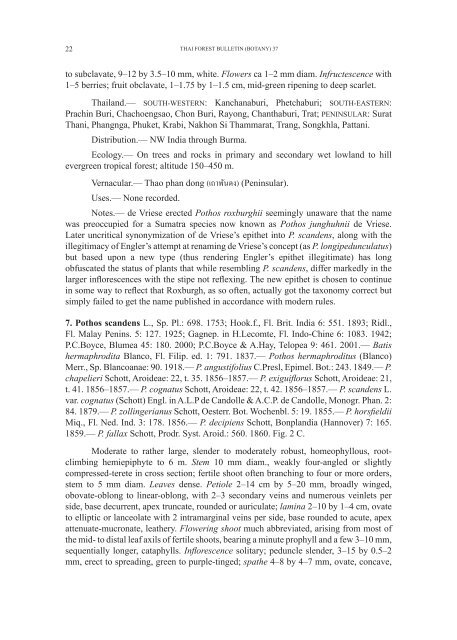Create successful ePaper yourself
Turn your PDF publications into a flip-book with our unique Google optimized e-Paper software.
22<br />
<strong>THAI</strong> <strong>FOREST</strong> <strong>BULLETIN</strong> (BOTANY) 37<br />
to subclavate, 9–12 by 3.5–10 mm, white. Flowers ca 1–2 mm diam. Infructescence with<br />
1–5 berries; fruit obclavate, 1–1.75 by 1–1.5 cm, mid-green ripening to deep scarlet.<br />
Thailand.— SOUTH-WESTERN: Kanchanaburi, Phetchaburi; SOUTH-EASTERN:<br />
Prachin Buri, Chachoengsao, Chon Buri, Rayong, Chanthaburi, Trat; PENINSULAR: Surat<br />
Thani, Phangnga, Phuket, Krabi, Nakhon Si Thammarat, Trang, Songkhla, Pattani.<br />
Distribution.— NW India through Burma.<br />
Ecology.— On trees and rocks in primary and secondary wet lowland to hill<br />
evergreen tropical forest; altitude 150–450 m.<br />
Vernacular.— Thao phan dong (เถาพันดง) (Peninsular).<br />
Uses.— None recorded.<br />
Notes.— de Vriese erected Pothos roxburghii seemingly unaware that the name<br />
was preoccupied for a Sumatra species now known as Pothos junghuhnii de Vriese.<br />
Later uncritical synonymization of de Vriese’s epithet into P. scandens, along with the<br />
illegitimacy of Engler’s attempt at renaming de Vriese’s concept (as P. longipedunculatus)<br />
but based upon a new type (thus rendering Engler’s epithet illegitimate) has long<br />
obfuscated the status of plants that while resembling P. scandens, differ markedly in the<br />
larger inflorescences with the stipe not reflexing. The new epithet is chosen to continue<br />
in some way to reflect that Roxburgh, as so often, actually got the taxonomy correct but<br />
simply failed to get the name published in accordance with modern rules.<br />
7. Pothos scandens L., Sp. Pl.: 698. 1753; Hook.f., Fl. Brit. India 6: 551. 1893; Ridl.,<br />
Fl. Malay Penins. 5: 127. 1925; Gagnep. in H.Lecomte, Fl. Indo-Chine 6: 1083. 1942;<br />
P.C.Boyce, Blumea 45: 180. 2000; P.C.Boyce & A.Hay, Telopea 9: 461. 2001.— Batis<br />
hermaphrodita Blanco, Fl. Filip. ed. 1: 791. 1837.— Pothos hermaphroditus (Blanco)<br />
Merr., Sp. Blancoanae: 90. 1918.— P. angustifolius C.Presl, Epimel. Bot.: 243. 1849.— P.<br />
chapelieri Schott, Aroideae: 22, t. 35. 1856–1857.— P. exiguiflorus Schott, Aroideae: 21,<br />
t. 41. 1856–1857.— P. cognatus Schott, Aroideae: 22, t. 42. 1856–1857.— P. scandens L.<br />
var. cognatus (Schott) Engl. in A.L.P de Candolle & A.C.P. de Candolle, Monogr. Phan. 2:<br />
84. 1879.— P. zollingerianus Schott, Oesterr. Bot. Wochenbl. 5: 19. 1855.— P. horsfieldii<br />
Miq., Fl. Ned. Ind. 3: 178. 1856.— P. decipiens Schott, Bonplandia (Hannover) 7: 165.<br />
1859.— P. fallax Schott, Prodr. Syst. Aroid.: 560. 1860. Fig. 2 C.<br />
Moderate to rather large, slender to moderately robust, homeophyllous, rootclimbing<br />
hemiepiphyte to 6 m. Stem 10 mm diam., weakly four-angled or slightly<br />
compressed-terete in cross section; fertile shoot often branching to four or more orders,<br />
stem to 5 mm diam. Leaves dense. Petiole 2–14 cm by 5–20 mm, broadly winged,<br />
obovate-oblong to linear-oblong, with 2–3 secondary veins and numerous veinlets per<br />
side, base decurrent, apex truncate, rounded or auriculate; lamina 2–10 by 1–4 cm, ovate<br />
to elliptic or lanceolate with 2 intramarginal veins per side, base rounded to acute, apex<br />
attenuate-mucronate, leathery. Flowering shoot much abbreviated, arising from most of<br />
the mid- to distal leaf axils of fertile shoots, bearing a minute prophyll and a few 3–10 mm,<br />
sequentially longer, cataphylls. Inflorescence solitary; peduncle slender, 3–15 by 0.5–2<br />
mm, erect to spreading, green to purple-tinged; spathe 4–8 by 4–7 mm, ovate, concave,
















